The global modularised emulsion plant market is projected to reach USD 809.1 million by 2035, recording an absolute increase of USD 307.7 million over the forecast period. The market is valued at USD 501.4 million in 2025 and is set to rise at a CAGR of 4.9% during the assessment period. The overall market size is expected to grow by nearly 1.6 times during the same period, supported by increasing road construction activities worldwide, driving demand for efficient emulsion production systems and growing investments in infrastructure development and highway construction projects globally. However, high initial investment costs and complex maintenance requirements for advanced emulsion plant systems may pose challenges to market expansion.
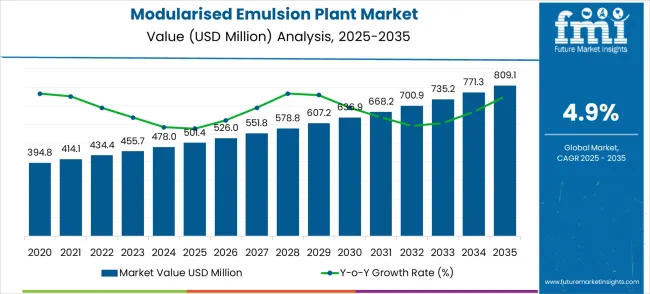
Between 2025 and 2030, the modularised emulsion plant market is projected to expand from USD 501.4 million to USD 636.9 million, resulting in a value increase of USD 135.5 million, which represents 44.0% of the total forecast growth for the decade. This phase of development will be shaped by rising demand for road construction and infrastructure development solutions, product innovation in emulsion technologies and production automation systems, as well as expanding integration with smart manufacturing and Industry 4.0 initiatives. Companies are establishing competitive positions through investment in advanced emulsion plant technologies, energy-efficient solutions, and strategic market expansion across construction, mining, and water conservancy applications.
From 2030 to 2035, the market is forecast to grow from USD 636.9 million to USD 809.1 million, adding another USD 172.2 million, which constitutes 56.0% of the overall ten-year expansion. This period is expected to be characterized by the expansion of specialized emulsion plant systems, including intelligent control platforms and integrated monitoring solutions tailored for specific construction applications, strategic collaborations between technology providers and construction equipment manufacturers, and an enhanced focus on production efficiency and environmental sustainability. The growing emphasis on automation of emulsion production processes and cost optimization will drive demand for advanced, modularised, high-capacity emulsion plant solutions across diverse infrastructure applications.
| Metric | Value |
|---|---|
| Market Value (2025) | USD 501.4 million |
| Market Forecast Value (2035) | USD 809.1 million |
| Forecast CAGR (2025-2035) | 4.9% |
The modularised emulsion plant market grows by enabling construction companies to ensure consistent emulsion quality and enhanced efficiency in road construction and infrastructure development processes. Construction contractors face mounting pressure to reduce production costs and improve project efficiency, with modularised emulsion systems typically requiring 50-65% less setup time than traditional alternatives, making modular solutions essential for competitive construction operations. The infrastructure development industry's need for continuous supply and quality consistency creates demand for advanced emulsion production solutions that can handle high-volume operations, maintain precise specifications, and ensure seamless production without quality variations or supply interruptions. Government initiatives promoting infrastructure development and road construction drive adoption in highway construction, mining operations, and water conservancy applications, where reliable emulsion production has a direct impact on project quality and operational efficiency. However, budget constraints for equipment upgrades and the complexity of integrating advanced systems with existing construction facilities may limit adoption rates among smaller contractors and developing regions with limited capital resources.
The modularised emulsion plant market represents a specialized yet strategically important infrastructure equipment opportunity driven by global road construction expansion, mining operations growth, and government infrastructure investment programs. As construction companies worldwide seek to reduce setup times by 50-65%, improve production efficiency, and ensure consistent emulsion quality, modularised solutions are transitioning from premium alternatives to essential competitive requirements for infrastructure contractors.
The convergence of massive infrastructure development programs across the Asia-Pacific, smart construction technology adoption, and Industry 4.0 integration creates sustained demand drivers across multiple end-markets. Geographic expansion opportunities are particularly pronounced in China (6.6% CAGR) and India (6.1% CAGR), where government-backed construction modernization and Belt and Road Initiative projects drive comprehensive infrastructure development.
Technology differentiation through intelligent automation systems, IoT connectivity, and predictive maintenance capabilities enables premium positioning, while application diversification beyond the dominant road construction segment (58.7% market share) into specialized mining and water conservancy applications opens higher-margin opportunities. The market's growth from USD 501.4 million in 2025 to USD 809.1 million by 2035 reflects fundamental shifts in construction industry requirements for efficient, automated emulsion production systems.
Rapid infrastructure development across China (6.6% CAGR) and India (6.1% CAGR) creates substantial expansion opportunities through local manufacturing partnerships, government infrastructure program participation, and regional supply chain development. Belt and Road Initiative projects, smart city construction programs, and highway development create sustained demand for efficient emulsion production systems. Localization strategies reduce import costs, enable faster project deployment, and position companies advantageously for government procurement programs while accessing growing domestic construction markets requiring specialized emulsion solutions. Expected revenue pool: USD 80-110 million
Development of smart emulsion plant systems featuring IoT connectivity, predictive maintenance capabilities, real-time production monitoring, and integration with construction management platforms transforms traditional equipment into intelligent production solutions. This pathway encompasses automated quality control systems, remote diagnostics, production optimization algorithms, and seamless integration with smart construction ecosystems. Premium positioning reflects enhanced operational efficiency and reduced maintenance costs, enabling service-based revenue models and ongoing customer relationships through data analytics and performance optimization services. Expected revenue pool: USD 65-95 million
Strengthening the dominant 5-15 tons/hour segment (46.8% market share) through advanced engineering, modular design innovations, and specialized configurations addressing diverse construction applications. This pathway focuses on optimal balance between production capacity and operational flexibility, enhanced automation features, and rapid deployment capabilities. Market leadership consolidation through superior engineering, comprehensive service support, and application-specific customization enables premium pricing while defending market position against competitive pressure from both smaller and larger capacity alternatives. Expected revenue pool: USD 55-80 million
Expansion beyond road construction (58.7% share) into specialized mining applications (23.6% share) and water conservancy engineering projects requiring customized emulsion solutions for dust control, slope stabilization, and environmental compliance. This pathway addresses high-value niche applications with specialized performance requirements, longer equipment lifecycles, and premium pricing reflecting technical sophistication and application-specific engineering. Mining sector environmental compliance trends and specialized infrastructure projects create opportunities for differentiated solutions with enhanced margins. Expected revenue pool: USD 45-70 million
Transformation from equipment sales to comprehensive service solutions, including maintenance contracts, operator training programs, performance optimization services, and equipment-as-a-service models addressing high capital investment barriers. This pathway leverages technical complexity and specialized expertise requirements to create recurring revenue streams while reducing customer capital expenditure concerns. Predictive maintenance capabilities, remote monitoring services, and comprehensive technical support enable higher customer lifetime values and market differentiation through service excellence. Expected revenue pool: USD 35-55 million
Development of environmentally superior emulsion production systems featuring energy-efficient operations, waste reduction technologies, emission control systems, and compliance with increasingly stringent environmental regulations across global markets. This pathway addresses growing regulatory pressures, corporate sustainability commitments, and government ecological initiatives requiring cleaner production technologies. Green technology positioning enables access to environmental incentives, sustainability-focused procurement programs, and premium pricing for environmentally superior solutions. Expected revenue pool: USD 30-50 million
Strategic partnerships with construction equipment manufacturers, automation technology providers, and smart construction platform developers are creating comprehensive infrastructure solutions extending beyond standalone emulsion plants. This pathway encompasses system integration capabilities, cross-platform compatibility, data sharing partnerships, and extensive construction automation solutions. Revenue diversification through technology licensing, integration services, and ecosystem partnerships supplements traditional equipment sales while strengthening competitive positioning and customer relationships across construction value chains. Expected revenue pool: USD 25-45 million
The market is segmented by production capacity, application, and region. By production capacity, the market is divided into capacity 0-5 tons/hour, capacity 5-15 tons/hour, capacity above 20 tons/hour, and others. Based on the application, the market is categorized into mining, water conservancy engineering, and road construction. Regionally, the market is divided into Asia Pacific, Europe, North America, and other key regions.
The capacity 5-15 tons/hour segment represents the dominant force in the modularised emulsion plant market, capturing approximately 46.8% of total market share in 2025. This mid-range capacity category encompasses plants equipped with sophisticated automation features, including computer numerical control (CNC) systems and programmable logic controllers (PLCs) that enable seamless production monitoring and quality control procedures. The medium-capacity segment's market leadership stems from its optimal balance between production capabilities and operational flexibility, with plants capable of producing sufficient emulsion volumes while maintaining consistent quality specifications and temperature control across all production runs.
The capacity 0-5 tons/hour segment maintains a substantial 28.4% market share, serving construction companies that require reliable emulsion production for smaller-scale operations. These plants offer cost-effective solutions for regional contractors while providing sufficient production volumes to meet local road construction and maintenance demands. The capacity above 20 tons/hour segment accounts for approximately 17.3% of the market, serving large-scale infrastructure projects requiring high-volume production capabilities. The remaining market segments, categorized as specialty or hybrid systems, account for approximately 7.5% of the market, serving niche applications requiring specific capacity configurations.
Key technological advantages driving the medium-capacity segment include:
Road construction applications dominate the modularised emulsion plant market with approximately 58.7% market share in 2025, reflecting the critical role of emulsion production in supporting global infrastructure development and highway construction activities. The road construction segment's market leadership is reinforced by increasing urbanization trends, government infrastructure investments, and rising demand for standardized emulsion solutions in highway and road maintenance projects worldwide.
The mining segment represents the second-largest application category, capturing 23.6% market share through specialized emulsion requirements for dust control, slope stabilization, and access road construction in mining operations. This segment benefits from growing demand for environmentally-compliant emulsion products that meet specific performance, durability, and environmental tolerance requirements in challenging mining environments.
The water conservancy engineering segment accounts for 17.7% market share, serving specialized infrastructure applications including dam construction, canal lining, and water management facility development.
Key market dynamics supporting application growth include:
The market is driven by three concrete demand factors tied to infrastructure development outcomes. First, road construction industry growth and infrastructure development create increasing demand for efficient emulsion production systems, with construction material requirements expanding by 10-12% annually in major developing countries worldwide, requiring comprehensive, modularised emulsion production infrastructure. Second, government initiatives promoting infrastructure development and smart construction drive mandatory adoption of automated production systems, with many countries setting targets for 30-50% modernization of construction processes by 2030. Third, technological advancements in control systems and production efficiency enable more reliable and cost-effective emulsion production solutions that reduce operational costs while improving system performance and product quality standards.
Market restraints include high capital investment requirements that can deter smaller construction companies from upgrading their production infrastructure, particularly in developing regions where funding for construction modernization remains limited. Technical complexity poses another significant challenge, as implementing advanced emulsion plant systems requires specialized expertise and training programs, potentially causing delays in project implementation and increased integration costs. Regulatory compliance requirements across different countries create additional complexity for manufacturers and operators, demanding ongoing adaptation to varying environmental standards and certification processes.
Key trends indicate accelerated adoption in Asia-Pacific markets, particularly China and India, where rapid infrastructure development and construction activity drive comprehensive emulsion plant system expansion. Design shifts toward intelligent emulsion production solutions with IoT connectivity, predictive maintenance capabilities, and integrated monitoring systems enable proactive maintenance approaches that reduce downtime and operational costs. However, the market thesis could face disruption if alternative road construction technologies or significant changes in emulsion application standards minimize reliance on traditional modularised emulsion plant systems.
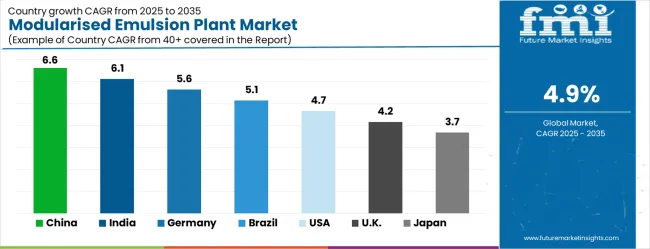
| Country | CAGR (2025-2035) |
|---|---|
| China | 6.6% |
| India | 6.1% |
| Germany | 5.6% |
| Brazil | 5.1% |
| USA | 4.7% |
| UK | 4.2% |
| Japan | 3.7% |
The modularised emulsion plant market is gathering pace worldwide, with China taking the lead thanks to massive infrastructure expansion and government-backed construction modernization programs. Close behind, India benefits from expanding road construction activities and smart infrastructure initiatives, positioning itself as a strategic growth hub in the Asia-Pacific region. Germany shows steady advancement, where integration of advanced emulsion technologies strengthens its role in the European construction equipment supply chain. Brazil is sharpening its focus on infrastructure modernization and road construction development, signaling an ambition to capitalize on the growing opportunities in South American infrastructure markets. Meanwhile, the USA stands out for its advanced technology adoption in existing construction systems, and the UK and Japan continue to record consistent progress in system modernization. Together, China and India anchor the global expansion story, while the rest build stability and diversity into the market's growth path.
The report covers an in-depth analysis of 40+ countries, the top-performing countries are highlighted below.
China demonstrates the strongest growth potential in the modularised emulsion plant market with a CAGR of 6.6% through 2035. The country's leadership position stems from massive infrastructure development projects, government-backed construction modernization programs, and stringent efficiency regulations driving the adoption of automated emulsion production systems. Growth is concentrated in major construction centers, including Beijing, Shanghai, Guangzhou, and Chengdu, where highway construction facilities and infrastructure complexes are implementing advanced emulsion plant solutions for enhanced operational efficiency and production quality. Distribution channels through state-owned construction enterprises and government-approved suppliers expand deployment across infrastructure projects and highway construction initiatives. The country's Belt and Road Initiative provides policy support for construction modernization initiatives, including advanced emulsion production system adoption.
Key market factors:
In Mumbai, Delhi, Bangalore, and Chennai, the adoption of modularised emulsion plant systems is accelerating across construction facilities and infrastructure projects, driven by rapid urbanization and government smart city initiatives. The market demonstrates strong growth momentum with a CAGR of 6.1% through 2035, linked to comprehensive infrastructure development and increasing focus on production efficiency solutions. Indian construction companies are implementing advanced emulsion production systems and monitoring platforms to enhance operational efficiency while meeting growing demand in expanding road construction and infrastructure sectors. The country's National Infrastructure Pipeline creates sustained demand for automated emulsion production solutions, while increasing emphasis on quality improvement drives adoption of advanced production systems.
Germany's advanced construction sector demonstrates sophisticated implementation of modularised emulsion plant systems, with documented case studies showing 35% production efficiency improvements in construction operations through intelligent automation platforms. The country's construction infrastructure in major industrial centers, including Munich, Berlin, Hamburg, and Frankfurt, showcases integration of advanced emulsion production technologies with existing construction systems, leveraging expertise in mechanical engineering and automation technologies. German construction companies emphasize precision engineering and quality standards, creating demand for high-performance emulsion plant solutions that support continuous improvement initiatives and production optimization requirements. The market maintains steady growth through focus on Industry 4.0 integration and sustainability compliance, with a CAGR of 5.6% through 2035.
Key development areas:
Brazil's market expansion is driven by diverse infrastructure demand, including highway construction in São Paulo and Rio de Janeiro, infrastructure development in Brasília and other major cities, and comprehensive construction modernization across multiple states. The country demonstrates promising growth potential with a CAGR of 5.1% through 2035, supported by federal government infrastructure investment programs and state-level construction development initiatives. Brazilian construction companies face implementation challenges related to capital investment constraints and technical expertise availability, requiring phased deployment approaches and financing support from international development banks. However, growing infrastructure demands and construction efficiency requirements create compelling business cases for emulsion plant system adoption, particularly in metropolitan areas where production efficiency has a direct impact on project competitiveness.
Market characteristics:
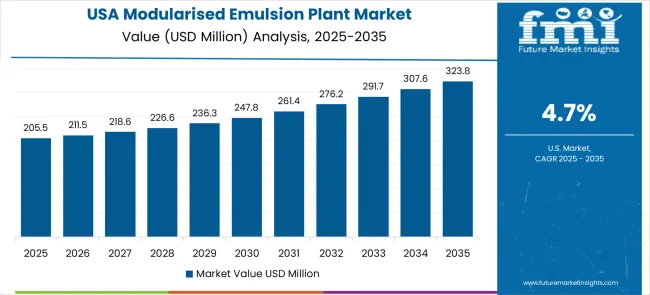
The USA market leads in advanced emulsion plant innovation based on integration with intelligent construction systems and smart infrastructure technologies for enhanced operational efficiency. The country shows strong potential with a CAGR of 4.7% through 2035, driven by the modernization of existing construction infrastructure and the expansion of automated production facilities in major construction areas, including Texas, California, Florida, and Illinois. American construction companies are adopting intelligent emulsion plant systems for operational efficiency improvement and regulatory compliance, particularly in regions with strict environmental standards and aging infrastructure requiring comprehensive upgrades. Technology deployment channels through established construction contractors and direct manufacturer relationships expand coverage across construction facilities and infrastructure operators.
Leading market segments:
In London, Manchester, Birmingham, and Glasgow, construction facilities are implementing modularised emulsion plant solutions to modernize aging production infrastructure and improve operational efficiency, with documented case studies showing a 25% reduction in production costs through advanced production management systems. The market shows moderate growth potential with a CAGR of 4.2% through 2035, linked to the ongoing modernization of construction facilities, infrastructure networks, and emerging automated construction projects in major cities. British construction companies are adopting intelligent emulsion production and monitoring platforms to enhance system reliability while maintaining production quality standards demanded by clients and regulatory authorities. The country's established construction infrastructure creates sustained demand for replacement and upgrade solutions that integrate with existing construction systems.
Market development factors:
Japan's Modularised Emulsion Plant Market demonstrates sophisticated implementation focused on precision engineering and operational excellence optimization, with documented integration of advanced production systems, achieving 28% improvement in production efficiency across construction and infrastructure facilities. The country maintains steady growth momentum with a CAGR of 3.7% through 2035, driven by construction facilities' emphasis on quality standards and continuous improvement methodologies that align with lean manufacturing principles applied to construction operations. Major metropolitan areas, including Tokyo, Osaka, Nagoya, and Fukuoka, showcase advanced deployment of intelligent emulsion production platforms where systems integrate seamlessly with existing construction control systems and comprehensive quality management programs.
Key market characteristics:
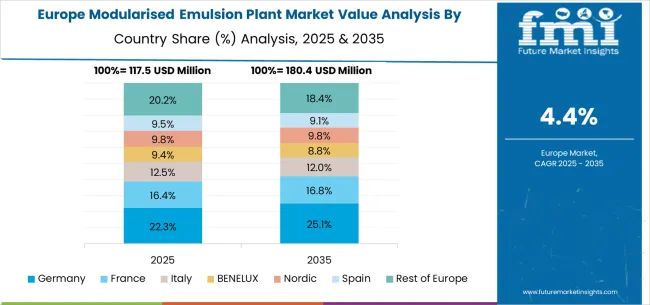
The modularised emulsion plant market in Europe is projected to grow from USD 125.4 million in 2025 to USD 202.3 million by 2035, registering a CAGR of 4.9% over the forecast period. Germany is expected to maintain its leadership position with a 32.1% market share in 2025, declining slightly to 31.6% by 2035, supported by its extensive construction infrastructure and major industrial centers, including Munich, Berlin, and Frankfurt construction facilities.
The United Kingdom follows with an 18.7% share in 2025, projected to reach 19.2% by 2035, driven by comprehensive construction modernization programs in London, Manchester, and other industrial areas implementing advanced emulsion plant systems. France holds a 16.2% share in 2025, expected to maintain 15.8% by 2035 through the ongoing development of construction facilities and infrastructure networks. Italy commands a 14.6% share, while Spain accounts for 11.3% in 2025. The Rest of Europe region is anticipated to gain momentum, expanding its collective share from 7.1% to 8.3% by 2035, attributed to increasing emulsion plant adoption in Nordic countries and emerging Eastern European construction facilities implementing infrastructure modernization programs.
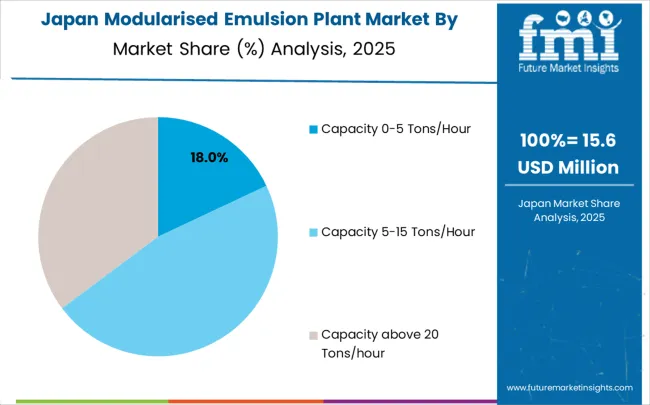
The Japanese Modularised Emulsion Plant Market demonstrates a mature and precision-focused landscape, characterized by sophisticated integration of capacity 5-15 tons/hour emulsion plant systems with existing construction control infrastructure across industrial facilities, construction supply networks, and automated production lines. Japan's emphasis on operational excellence and quality standards drives demand for high-reliability emulsion production solutions that support kaizen continuous improvement initiatives and statistical process control requirements in construction operations.
The market benefits from strong partnerships between international technology providers like BME, Dyno Nobel, and domestic industrial equipment leaders, including Mitsubishi Heavy Industries, Komatsu, and Nippon Steel, creating comprehensive service ecosystems that prioritize system reliability and operator training programs. Construction centers in Tokyo, Osaka, Nagoya, and other major industrial areas showcase advanced predictive maintenance implementations where emulsion plant systems achieve 97% uptime through integrated monitoring programs.
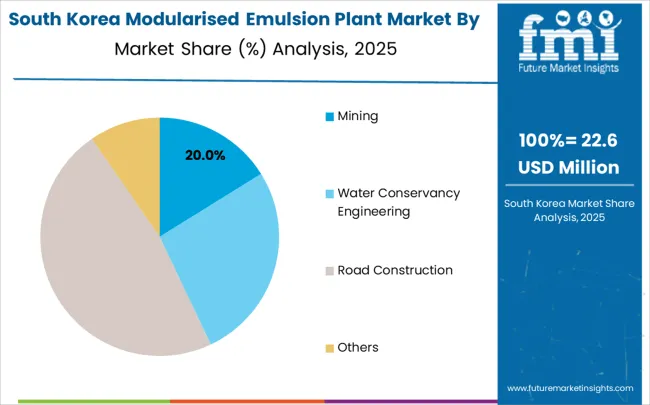
The South Korean Modularised Emulsion Plant Market is characterized by strong international technology provider presence, with companies like BME, Dyno Nobel, and Vialab maintaining dominant positions through comprehensive system integration and maintenance services capabilities for construction facilities and infrastructure applications. The market is demonstrating a growing emphasis on localized technical support and rapid response capabilities, as Korean construction companies increasingly demand customized solutions that integrate with domestic construction infrastructure and advanced production control systems deployed across the Seoul Metropolitan Area and other major industrial cities.
Local construction equipment companies and regional system integrators are gaining market share through strategic partnerships with global providers, offering specialized services including technical training programs and certification services for maintenance personnel. The competitive landscape shows increasing collaboration between multinational emulsion plant manufacturers and Korean construction technology specialists, creating hybrid service models that combine international mechanical engineering expertise with local market knowledge and customer relationship management.
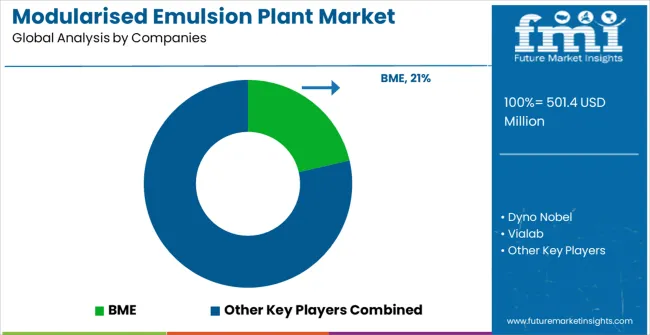
The modularised emulsion plant market features approximately 20-25 meaningful players with moderate concentration, where the top three companies control roughly 38-45% of global market share through established technology platforms and extensive construction industry relationships. Competition centers on technological innovation, service capabilities, and production efficiency rather than price competition alone.
Market leaders include BME, Dyno Nobel, and Vialab, which maintain competitive advantages through comprehensive emulsion production solution portfolios, global service networks, and deep expertise in the construction and infrastructure sector, creating high switching costs for customers. These companies leverage installed base relationships and ongoing maintenance contracts to defend market positions while expanding into adjacent construction system applications.
Challengers encompass WM Matos and Tread, which compete through specialized emulsion plant solutions and strong regional presence in key construction markets. Technology specialists, including Nipigormash, Azottech, and IEE Global, focus on specific emulsion production technologies or vertical applications, offering differentiated capabilities in automation control, production optimization, and monitoring platforms.
Regional players and emerging technology providers create competitive pressure through cost-effective solutions and rapid deployment capabilities, particularly in high-growth markets including China and India, where local presence provides advantages in customer support and regulatory compliance. Market dynamics favor companies that combine advanced emulsion production technologies with comprehensive service offerings that address the complete plant lifecycle from design through ongoing maintenance and optimization.
| Item | Value |
|---|---|
| Quantitative Units | USD 501.4 million |
| Production Capacity | Capacity 0-5 Tons/Hour, Capacity 5-15 Tons/Hour, Capacity above 20 Tons/hour, Others |
| Application | Mining, Water Conservancy Engineering, Road Construction |
| Regions Covered | Asia Pacific, Europe, North America, Latin America, Middle East & Africa |
| Country Covered | China, India, Germany, Brazil, the USA, the UK, Japan, and 40+ countries |
| Key Companies Profiled | BME, Dyno Nobel, Vialab, WM Matos, Tread, Nipigormash, Azottech, IEE Global, ZETA, Beomach |
| Additional Attributes | Dollar sales by production capacity and application categories, regional adoption trends across Asia Pacific, Europe, and North America, competitive landscape with technology providers and system integrators, construction facility requirements and specifications, integration with smart construction initiatives and IoT platforms, innovations in emulsion plant technology and monitoring systems, and development of specialized applications with efficiency and quality capabilities. |
The global modularised emulsion plant market is estimated to be valued at USD 501.4 million in 2025.
The market size for the modularised emulsion plant market is projected to reach USD 809.1 million by 2035.
The modularised emulsion plant market is expected to grow at a 4.9% CAGR between 2025 and 2035.
The key product types in modularised emulsion plant market are capacity 0-5 tons/hour, capacity 5-15 tons/hour and capacity above 20 tons/hour.
In terms of application, mining segment to command 0.0% share in the modularised emulsion plant market in 2025.






Our Research Products

The "Full Research Suite" delivers actionable market intel, deep dives on markets or technologies, so clients act faster, cut risk, and unlock growth.

The Leaderboard benchmarks and ranks top vendors, classifying them as Established Leaders, Leading Challengers, or Disruptors & Challengers.

Locates where complements amplify value and substitutes erode it, forecasting net impact by horizon

We deliver granular, decision-grade intel: market sizing, 5-year forecasts, pricing, adoption, usage, revenue, and operational KPIs—plus competitor tracking, regulation, and value chains—across 60 countries broadly.

Spot the shifts before they hit your P&L. We track inflection points, adoption curves, pricing moves, and ecosystem plays to show where demand is heading, why it is changing, and what to do next across high-growth markets and disruptive tech

Real-time reads of user behavior. We track shifting priorities, perceptions of today’s and next-gen services, and provider experience, then pace how fast tech moves from trial to adoption, blending buyer, consumer, and channel inputs with social signals (#WhySwitch, #UX).

Partner with our analyst team to build a custom report designed around your business priorities. From analysing market trends to assessing competitors or crafting bespoke datasets, we tailor insights to your needs.
Supplier Intelligence
Discovery & Profiling
Capacity & Footprint
Performance & Risk
Compliance & Governance
Commercial Readiness
Who Supplies Whom
Scorecards & Shortlists
Playbooks & Docs
Category Intelligence
Definition & Scope
Demand & Use Cases
Cost Drivers
Market Structure
Supply Chain Map
Trade & Policy
Operating Norms
Deliverables
Buyer Intelligence
Account Basics
Spend & Scope
Procurement Model
Vendor Requirements
Terms & Policies
Entry Strategy
Pain Points & Triggers
Outputs
Pricing Analysis
Benchmarks
Trends
Should-Cost
Indexation
Landed Cost
Commercial Terms
Deliverables
Brand Analysis
Positioning & Value Prop
Share & Presence
Customer Evidence
Go-to-Market
Digital & Reputation
Compliance & Trust
KPIs & Gaps
Outputs
Full Research Suite comprises of:
Market outlook & trends analysis
Interviews & case studies
Strategic recommendations
Vendor profiles & capabilities analysis
5-year forecasts
8 regions and 60+ country-level data splits
Market segment data splits
12 months of continuous data updates
DELIVERED AS:
PDF EXCEL ONLINE
Bitumen Emulsion Plants Market Size and Share Forecast Outlook 2025 to 2035
Plant-Based Feed Ingredients Market Size and Share Forecast Outlook 2025 to 2035
Plant-Based Vitamin D3 Supplements Market Size and Share Forecast Outlook 2025 to 2035
Plant Moisture Tester Market Size and Share Forecast Outlook 2025 to 2035
Plant Genome Extraction Kit Market Size and Share Forecast Outlook 2025 to 2035
Plant Derived Analgesics Market Size and Share Forecast Outlook 2025 to 2035
Plant Based Beverage Market Forecast and Outlook 2025 to 2035
Plant-based Body Paint Pigments Market Size and Share Forecast Outlook 2025 to 2035
Plant Based Plastic Market Forecast and Outlook 2025 to 2035
Plant Stem Cell Encapsulation Market Analysis - Size and Share Forecast Outlook 2025 to 2035
Emulsion Polymers Market Size and Share Forecast Outlook 2025 to 2035
Plant Stem Cell Skincare Product Market Size and Share Forecast Outlook 2025 to 2035
Plant-based Cheese Market Size and Share Forecast Outlook 2025 to 2035
Plant Based Meat Packaging Market Size and Share Forecast Outlook 2025 to 2035
Emulsion Stabilizers Market Size and Share Forecast Outlook 2025 to 2035
Plant Sterol Supplements Market Size and Share Forecast Outlook 2025 to 2035
Plant Protein Hydrolysate Market Size and Share Forecast Outlook 2025 to 2035
Plant Asset Management Market Size and Share Forecast Outlook 2025 to 2035
Plant-Derived Hyaluronic Acid Alternatives Market Analysis - Size, Share, and Forecast Outlook 2025 to 2035
Plant Peptides Market Size and Share Forecast Outlook 2025 to 2035

Thank you!
You will receive an email from our Business Development Manager. Please be sure to check your SPAM/JUNK folder too.
Chat With
MaRIA